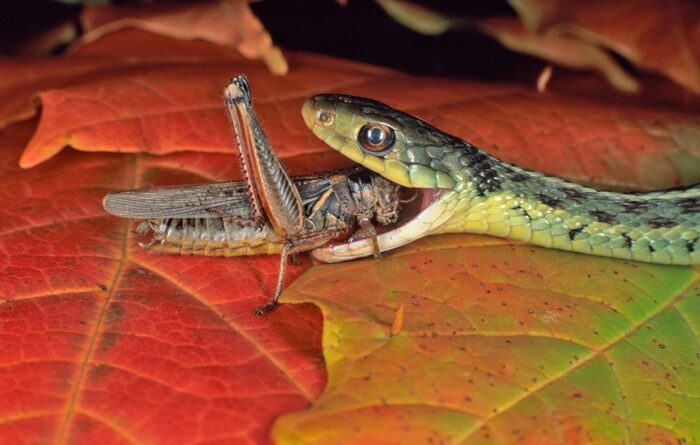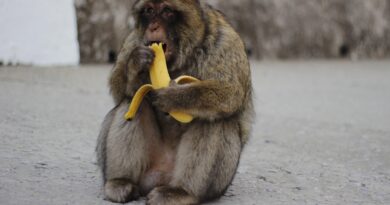Do Snakes Eat Grasshoppers? Unveiling the Truth About Their Diet
Snakes have long been fascinating creatures in the animal kingdom, known for their unique feeding habits and dietary adaptations. From constricting prey to swallowing it whole, snakes have a diet that sparks curiosity. One commonly asked question is, “Do snakes eat grasshoppers?” This article dives deep into the dietary habits of snakes, exploring whether grasshoppers form a part of their meals and unraveling the broader spectrum of what these reptiles consume.
Understanding the Snake’s Diet
Carnivorous by Nature
Snakes are predominantly carnivorous. Unlike omnivorous animals, they do not consume plant material or vegetation. Their bodies are specifically designed to process animal proteins. A snake’s diet varies greatly depending on its size, habitat, and species, but one constant is their reliance on other animals for sustenance.
Hunting Techniques
Snakes employ a variety of hunting strategies. Some species rely on ambush tactics, lying in wait for unsuspecting prey, while others actively pursue their food. Whether using venom or constriction, snakes have evolved to effectively capture and subdue their meals.
Do Snakes Eat Insects?
Insects as a Food Source
Insects, including grasshoppers, are indeed a part of the diet for some smaller snake species. Baby snakes, in particular, may rely on insects due to their small size and the relative ease of capturing such prey. However, not all snakes consume insects.
Which Snakes Eat Grasshoppers?
Certain species, such as garter snakes and rough green snakes, have been observed eating grasshoppers and other insects. These snakes are often smaller and more adaptable, living in environments where insects are abundant.
Nutritional Value of Grasshoppers for Snakes
Grasshoppers are rich in protein, making them a nutritious option for snakes. For small snakes or juveniles, grasshoppers can provide the necessary energy and nutrients to fuel their growth and survival. However, larger snakes may find grasshoppers insufficient due to their small size and lower caloric value compared to larger prey.
Factors That Influence Snake Diets
Species
The type of snake greatly influences its diet. For example, a python’s diet is vastly different from that of a garter snake. While pythons prey on large mammals and birds, smaller snakes are more likely to consume insects and amphibians.
Habitat
Snakes’ diets are also shaped by their habitats. Snakes in forested areas may have access to a variety of insects, including grasshoppers, whereas those in deserts might consume lizards or small mammals more frequently.
Size
A snake’s size dictates what it can physically consume. Small snakes have smaller mouths and less powerful digestion, making them more likely to feed on insects and other small prey.
How Do Snakes Capture Grasshoppers?
Ambush Predators
Many snakes use their keen senses to detect the vibrations and movements of grasshoppers. By staying motionless and blending into their surroundings, they can ambush unsuspecting prey.
Quick Strikes
When targeting fast-moving prey like grasshoppers, snakes rely on their speed and precision. A quick strike ensures the grasshopper is captured before it can escape.
Do All Snakes Eat Grasshoppers?
No, not all snakes eat grasshoppers. Larger snakes, such as boas and anacondas, require more substantial prey to meet their dietary needs. Grasshoppers are not practical for these species due to their size and low energy return.
Other Common Prey for Snakes
Small Mammals
Rodents are a staple for many snake species, providing a high-calorie meal that can sustain them for days or even weeks.
Birds and Eggs
Some snakes, particularly tree-dwelling species, feed on birds and their eggs.
Amphibians
Frogs and toads are common prey for water snakes and other species that inhabit wet environments.
Other Reptiles
Lizards and even smaller snakes can become meals for larger or more aggressive snake species.
The Role of Grasshoppers in the Ecosystem
Grasshoppers play a crucial role in the ecosystem, serving as both herbivores and prey. Their consumption by snakes and other predators helps maintain ecological balance. Understanding this relationship highlights the interconnectedness of all species.
Misconceptions About Snake Diets
There are several myths surrounding snake diets, including the belief that snakes eat plants or vegetation. It’s important to clarify that snakes are obligate carnivores and do not derive nutrition from non-animal sources.
Do Pet Snakes Eat Grasshoppers?
Feeding Pet Snakes
For pet owners, providing an appropriate diet for their snake is essential. While some species of pet snakes can eat grasshoppers, it’s crucial to ensure that the insects are free from pesticides and other harmful substances.
Commercial Alternatives
Pet owners can also opt for pre-packaged frozen prey or live insects from reputable suppliers, ensuring their snake receives proper nutrition.
How Often Do Snakes Eat?
The frequency of feeding depends on the snake’s species, size, and age. Smaller snakes eating grasshoppers may feed more frequently than larger snakes consuming mammals or birds.
Grasshoppers as a Seasonal Food Source
Grasshoppers are more abundant in certain seasons, especially during warmer months. Snakes living in temperate regions may incorporate grasshoppers into their diet when they are plentiful.
Conclusion: Do Snakes Eat Grasshoppers?
In summary, the answer is yes—some snakes do eat grasshoppers. However, the inclusion of grasshoppers in a snake’s diet depends on the species, size, and habitat of the snake. Grasshoppers can provide a nutritious meal for smaller snakes or juveniles, but they are not a significant food source for larger species.
By understanding the diverse dietary habits of snakes, we gain a deeper appreciation for these remarkable creatures and their role in maintaining ecological balance. Whether in the wild or as pets, snakes continue to captivate us with their unique feeding behaviors and adaptability
The Evolution of Snake Diets
How Diet Shaped Snake Evolution
The dietary habits of snakes have evolved over millions of years. Fossil evidence shows that ancient snakes consumed a variety of prey, and their jaw structures adapted to enable them to swallow meals whole, regardless of size. This evolutionary flexibility has allowed snakes to thrive in diverse environments.
Adaptations for Consuming Different Prey
The evolution of specialized hunting methods, venom production, and jaw flexibility highlights how snakes have diversified their diets. While some species have maintained insect-based diets, others have transitioned to larger prey, demonstrating the adaptability of their feeding mechanisms.
The Importance of Biodiversity in Snake Diets
Snakes as Ecological Balancers
By consuming prey like grasshoppers, snakes help control insect populations, preventing overgrazing on vegetation. This makes them vital players in maintaining biodiversity and ecosystem health.
Impact of Habitat Loss on Snake Diets
Habitat destruction and urbanization threaten snake populations and the availability of their natural prey, including grasshoppers. Conservation efforts are critical to preserving these intricate food web relationships.
Frequently Asked Questions About Snake Diets
1. Do all baby snakes eat grasshoppers?
Not all baby snakes eat grasshoppers, but smaller species or juveniles often include insects in their diet. Other snakes may feed on small amphibians or rodents depending on their environment.
2. Are grasshoppers safe for pet snakes?
Yes, grasshoppers can be safe for pet snakes as long as they are pesticide-free and sourced from reliable suppliers. However, it’s essential to ensure they match the dietary needs of the specific snake species.
3. Can large snakes like pythons ever eat grasshoppers?
While technically possible, large snakes like pythons typically require much larger prey to meet their caloric needs. Grasshoppers are not practical or sufficient for such species




